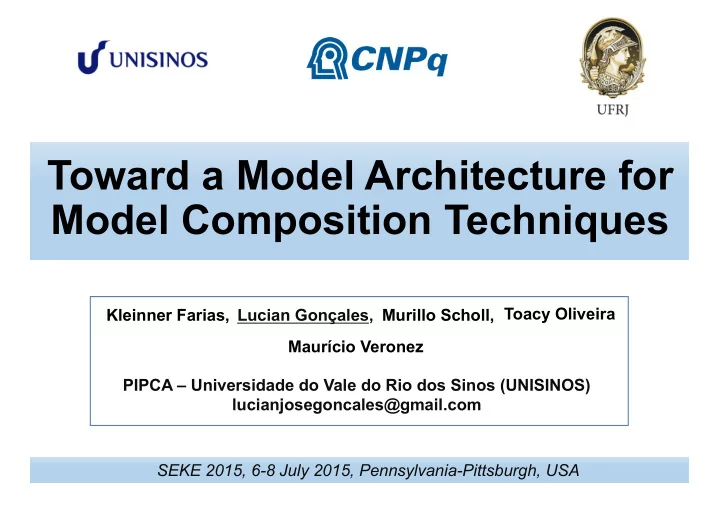

Toward a Model Architecture for Model Composition Techniques Murillo Scholl, Toacy Oliveira Kleinner Farias, Lucian Gonçales, Maurício Veronez PIPCA – Universidade do Vale do Rio dos Sinos (UNISINOS) lucianjosegoncales@gmail.com SEKE 2015, 6-8 July 2015, Pennsylvania-Pittsburgh, USA
Introduction Model composition : MA and MB, in order to produce an • output-intended model, MAB. It is an important task in MDE (Model Driven Engineering) • Evolving design models • reconciling multi-view models ( parallel development ). • Actually, Merging is a “time-consuming, complicated, and error-prone • process” [Ton Mens]; Current composition tools are limited and closed to a set of particular • composition cases; To overcome these shortcomings: We proposed an model architecture. •
Background
Background o Model Matching Strategies o Default: Find the model correspondence between component names; o Partial: Matches the elements according its syntactic properties; o Complete: Comparison using syntactic and semantic model properties;
MoCoTo Composition Process
MoCoTo Composition Process
MoCoTo Composition Process
MoCoTo architecture feature model mocoto_feature_model
MoCoTo architectural components COMPARISON ANALYSIS COMPARISON A Analysis A STRATEGY C C C Comparison FEATURES M Composition Comparison E Evaluation Analysis Service Persistence P Comparison Strategy Strategy Evaluation Strategy MOCOTO EVALUATION A E ENGINE COMPOSITION C E M P STRATEGY Legend: M Composition Component Persistense Strategy Provided interface Strategy Composition Required interface Service PERSISTENCE COMPOSITION P M Aspectual component Aspectual connector
MoCoto Eclipse Plugin
Conclusion and future work • This paper introduced a flexible, component-based architecture for supporting the development of model composition techniques; • The preliminary results have indicated that the proposed architecture is able to support the development of composition tools for UML models. • The future investigations: • Do developers invest significantly more effort to develop a new composition technique than derive one from MoCoTo-Arch? • How effective is MoCoTo to combine realistic, semantically richer design models?
References [1] T. Mens, “A state-of-the-art survey on software merging,” IEEE Trans. Softw. Eng. 28(5), 449–562, 2002. [2] J. Whittle, P. Jayaraman, “Synthesizing hierarchical state machines from expressive scenario descriptions,” ACM TOSEM, 19(3), 1–45, 2010. [3] K. Farias et al , “A flexible strategy-based model comparison approach: bridging the syntactic and semantic gap,” Journal of Universal Computer Science, 15(11):2225- 2253, 2009. [4] S. She, U. Ryssel, N. Andersen, A. Wasowski, K. Czarnecki. “Efficient synthesis of feature models”, Information & Software Technology , 56(9): 1122-1143, 2014. [5] K.Farias, A. Garcia, & C. Lucena “Effects of stability on model composition effort: an exploratory study”. Software & Systems Modeling , vol. 13, number 4, pp. 1473- 1494, 2014. [6] K. Farias. Empirical Evaluation of Effort on Composing Design Models (Doctoral dissertation, PUC-Rio). 2012. [7] K. Farias. Empirical evaluation of effort on composing design models. In 2010 ACM/IEEE 32nd International Conference on Software Engineering, vol. 2, pp. 405- 408, IEEE, 2010.
Recommend
More recommend